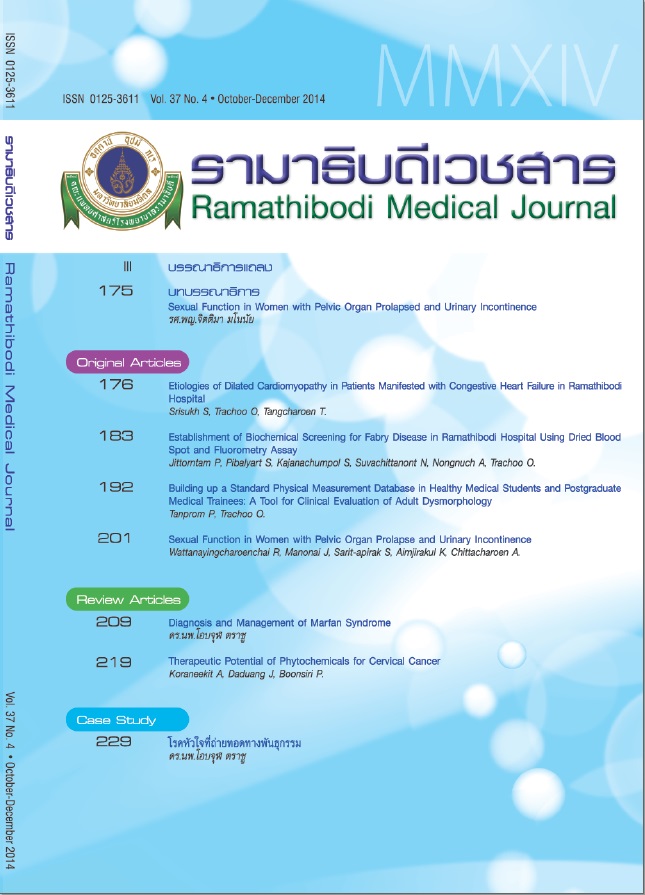Sexual Function in Women With Pelvic Organ Prolapsed and Urinary Incontinence
Main Article Content
Abstract
Objective: To describe the sexual function of women with pelvic organ prolapse and urinary incontinence and to investigate the association between the presence of pelvic floor symptoms and degree of bother related to their problems and sexual function using a condition-specific function questionnaire.
Methods: Women with pelvic organ prolapse/urinary incontinence, attending the Urogynaecology Clinic, Ramathibodi Hospital were recruited in the study. Information about the presence and degree of bother related to pelvic floor symptoms over the previous 1 month and sexual function were assessed; using the Thai version Pelvic Floor Bother Questionnaire (PFEQ) and the Thai version Pelvic Organ Prolapse/Urinary Incontinence Sexual Questionnaire (PISQ-12), respectively.
Results: The subjects were 289 women aged 60.9 ± 11.4 years. One hundred and eight (65%) were sexually active. There was no difference in sexual activity in women with different pelvic floor symptoms. Compared to sexually inactive group, sexually active women had significantly higher PFBQ score. Regarding to pelvic floor problems, there was no statistically significant difference in PISQ-12 scores in women with different pelvic floor symptoms. The degree of bother related to pelvic floor problems was significantly correlated with impairment of sexual function.
Conclusions: Pelvic organ prolapse and urinary incontinence have an impact on sexual function. Women with more bother related to pelvic floor problems have more sexual impairment.
Article Details
References
Brown JS, Posner SF, Stewart AL. Urge incontinence: new health-related quality of life measures. J Am Geriatr Soc. 1999;47(8):980-988.
Barber MD, Kuchibhatla MN, Pieper CF, Bump RC. Psychometric evaluation of 2 comprehensive condition-specific quality of life instruments for women with pelvic floor disorders. Am J Obstet Gynecol. 2001;185(6):1388-1395.
Defining sexual health: report of a technical consultation on sexual health, 28-31 January 2002. World Health Organization, Geneva 2006.
Pons ME. Sexual health in women with pelvic floor disorders: measuring the sexual activity and function with questionnaires--a summary. Int Urogynecol J Pelvic Floor Dysfunct. 2009;20 Suppl 1:S65-S71. doi:10.1007/s00192-009-0828-7.
Pauls RN, Segal JL, Silva WA, Kleeman SD, Karram MM. Sexual function in patients presenting to a urogynecology practice. Int Urogynecol J Pelvic Floor Dysfunct. 2006;17(6):576-580.
Weber AM, Walters MD, Schover LR, Mitchinson A. Sexual function in women with uterovaginal prolapse and urinary incontinence. Obstet Gynecol. 1995;85(4):483-487.
Rogers GR, Villarreal A, Kammerer-Doak D, Qualls C. Sexual function in women with and without urinary incontinence and/or pelvic organ prolapse. Int Urogynecol J Pelvic Floor Dysfunct. 2001;12(6):361-365.
Lukacz ES, Whitcomb EL, Lawrence JM, Nager CW, Contreras R, Luber KM. Are sexual activity and satisfaction affected by pelvic floor disorders? Analysis of a community-based survey. Am J Obstet Gynecol. 2007;197(1):88.e1-88.e6.
Fashokun TB, Harvie HS, Schimpf MO, et al. Sexual activity and function in women with and without pelvic floor disorders. Int Urogynecol J. 2013;24(1):91-97. doi:10.1007/s00192-012-1848-2.
Peterson TV, Karp DR, Aguilar VC, Davila GW. Validation of a global pelvic floor symptom bother questionnaire. Int Urogynecol J. 201021(9):1129-1135. doi:10.1007/s00192-010-1148-7.
Rogers RG, Kammerer-Doak D, Villarreal A, Coates K, Qualls C. A new instrument to measure sexual function in women with urinary incontinence or pelvic organ prolapse. Am J Obstet Gynecol. 2001;184(4):552-558.
Rogers RG, Coates KW, Kammerer-Doak D, Khalsa S, Qualls C. A short form of the Pelvic Organ Prolapse/Urinary Incontinence Sexual Questionnaire (PISQ-12). Int Urogynecol J Pelvic Floor Dysfunct. 2003;14(3):164-168.
Mouritsen L. Pathophysiology of sexual dysfunction as related to pelvic floor disorders. Int Urogynecol J Pelvic Floor Dysfunct. 2009;20(Suppl 1):S19-S25. doi:10.1007/s00192-009-0831-z.
Pons ME. Sexual health of women with pelvic floor disorders. Int Urogynecol J Pelvic Floor Dysfunct. 2009;20(Suppl 1):S5-S7. doi:10.1007/s00192-009-0827-8.
Dennerstein L, Alexander JL, Kotz K. The menopause and sexual functioning: a review of the population-based studies. Annu Rev Sex Res. 2003;14:64-82.
Rogers RG. Sexual function in women with pelvic floor disorders. Can Urol Assoc J. 2013;7(9-10 Suppl 4):S199-S201. doi:10.5489/cuaj.1625.
Lindau ST, Schumm LP, Laumann EO, Levinson W, O'Muircheartaigh CA, Waite LJ. A study of sexuality and health among older adults in the United States. N Engl J Med. 2007;357(8):762-774.
Panman CM, Wiegersma M, Talsma MN, et al. Sexual function in older women with pelvic floor symptoms: a cross-sectional study in general practice. Br J Gen Pract. 2014;64(620):e144-e150. doi:10.3399/bjgp14X677518.
Handa VL, Cundiff G, Chang HH, Helzlsouer KJ. Female sexual function and pelvic floor disorders. Obstet Gynecol. 2008;111(5):1045-1052. doi:10.1097/AOG.0b013e31816bbe85.
Lowenstein L, Gamble T, Sanses TV, et al. Sexual function is related to body image perception in women with pelvic organ prolapse. J Sex Med. 2009;6(8):2286-2291. doi:10.1111/j.1743-6109.2009.01329.x.
Omotosho TB, Rogers RG. Shortcomings/strengths of specific sexual function questionnaires currently used in urogynecology: a literature review. Int Urogynecol J Pelvic Floor Dysfunct. 2009;20(Suppl 1):S51-S56. doi:10.1007/s00192-009-0829-6.
